This fun and educational moldy bread experiment will show you what factors influence mold growth and how to prevent it. It’s a perfect project for science fairs!
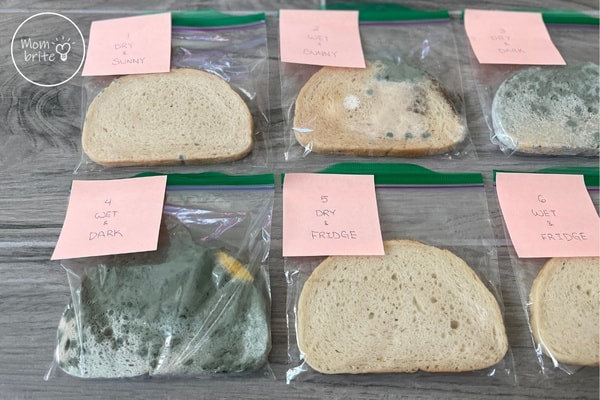
Are you tired of throwing out food that has gone moldy far before its expiration date? Ever been curious about what causes bread to spoil so quickly?
If so, then this moldy bread experiment is perfect for you! You will have so much fun investigating the effects of humidity and temperature on mold growth with your kids. And while the fuzzy mold is a bit disgusting, it is contained in plastic bags so you don’t need to worry about touching or breathing in mold.
This molding bread science experiment will take several days, so make sure you leave plenty of time for the science project. Your kids will get to observe the stages of mold growth up close and find the conditions in which you should store your bread at home.
What is Mold?
Mold is an unwelcome house guest, often lurking in dark and damp areas. But did you know it’s made up of tiny organisms called hyphae and spores that work together to form colonies? Chances are this hidden fungus can be sneaking around inside your home or even on the food products you buy – so watch out!
Mold on bread is caused by various factors, including lack of hygiene practices in the kitchen, the use of old or stale bread, improper storage either at home or in commercial bakeries, high humidity levels, and insufficient sunlight exposure.
Different types of mold can be found on bread. Some include Penicillium (blue-green), Aspergillus (gray-green), and Alternaria (dark green). These molds occur when moisture is present in the environment along with warm temperatures. Bread that has been stored for too long or not packaged properly is most likely to suffer from mold growth.
How to Perform the Moldy Bread Experiment
There are many ways to perform the moldy bread science experiment. It all depends on what you want to test!
Here are several ideas for your experiment:
- Sunny vs. dark
- Dry vs. wet
- Cold vs. warm
- Preservatives vs. no preservatives
- Open bag vs. closed bag
- Paper bag vs. plastic bag
After you decide what conditions to test, have your kid form a hypothesis as part of the scientific method. To form a hypothesis, your kid needs to think about what he or she thinks will happen to the bread. For example, the hypothesis could be, “I think the bread will grow mold faster in a dark and wet environment.”
Our moldy bread experiment tested what happens to the bread in a dark vs. sunny, wet vs. dry, and cold vs. warm environment. These are the typical environments to which we expose our bread from the grocery store, so we wanted to know what factors influence mold growth on bread so that we can extend its shelf life.
Materials:
- 6 slices of bread (any type will be fine as long as they are all from the same loaf)
- Resealable bags
- Sticky notes
- Pen or pencil (you can also use a permanent marker and write directly on the bags)
Instructions:
1. Place a slice of bread in each resealable bag.
2. Label each bag with the conditions you are subjecting the slice of bread to. Some people skip this step, but I believe labeling all the bags accordingly is crucial to avoid confusion in the observation step.
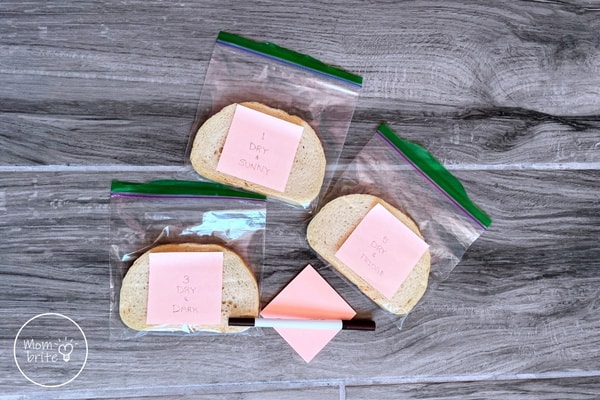
3. Prepare the bread slices. We sprayed 3 of the bread pieces with some water.
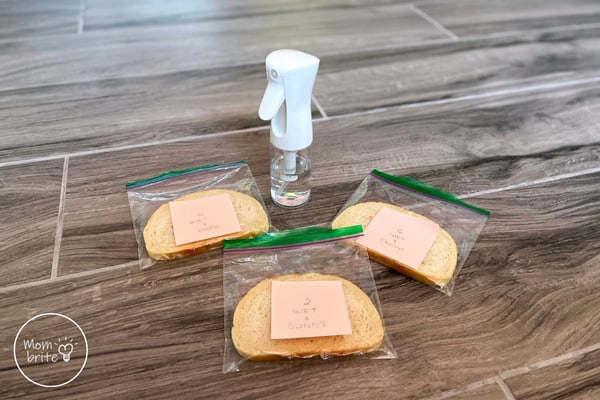
4. Place the bags in the appropriate areas of the house. We put a couple of bread slices near the window to get sun exposure, a couple in the kitchen cabinets to keep them in the dark, and a couple in the fridge to see how the temperature would affect the mold growth on the bread.
5. Leave the bread alone to allow mold to grow! Since we used store-bought bread with preservatives, it took a few days before any mold showed up. If you want faster results, I recommend buying bread without preservatives.
Molding Bread Science Experiment Results
After about a week, we compared all the bread slices side by side.
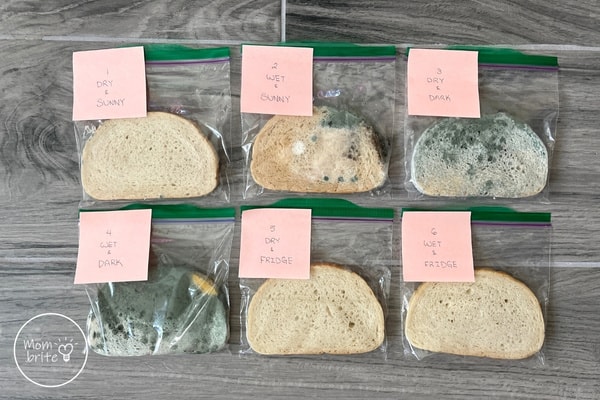
Not surprisingly, the bread that was wet and stored in a dark environment had the most mold growth. The mold growth was drastically greater than that of the other bread pieces, and it was pretty disgusting if you ask me!
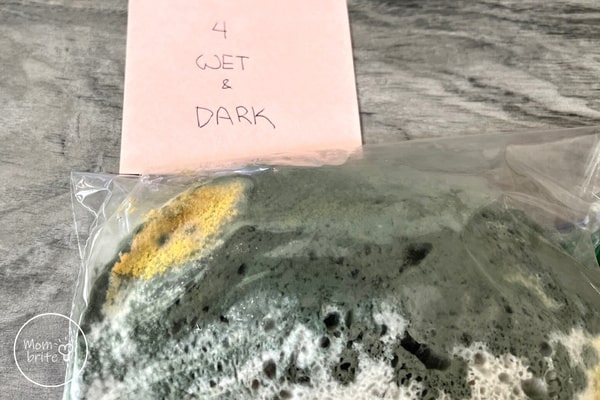
Upon close observation, there appeared to be three types of mold growth on the “wet and dark” slice: gray-green mold, white mold, and yellow mold.
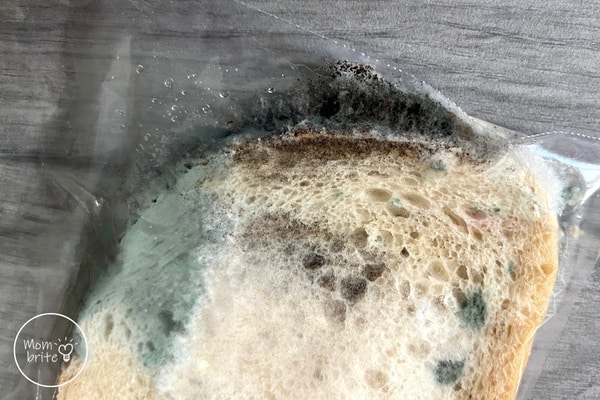
The wet and sunny bread slice had some black and fuzzy mold growing on it. You could see the mold growing out from the edge of the bread piece. Yuck!
Then, we looked at two bread slices that had one common environmental factor side by side for comparison.
Comparison 1: “Wet & Sunny” vs. “Wet & Dark”:
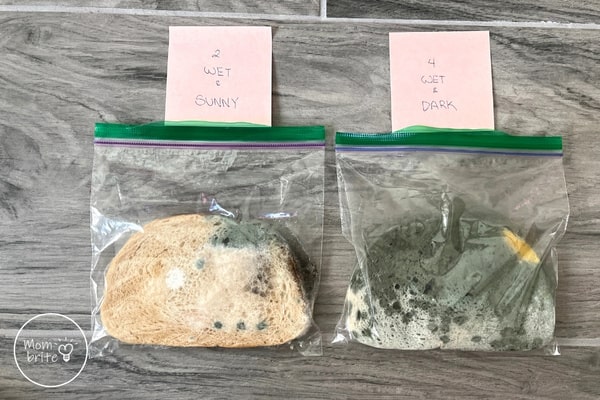
While both bread slices had mold growth, the one in the kitchen cabinet had much more. Therefore, sunlight has an effect on preventing mold growth.
Comparison 2: “Dry & Sunny” vs. “Dry & Dark”:
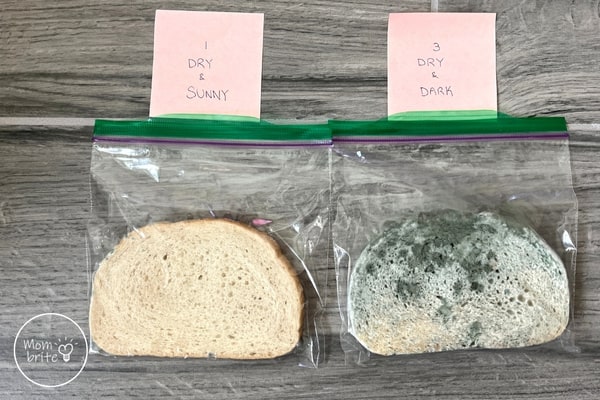
My personal hypothesis was that keeping the bread slices dry would prevent mold growth, but I was wrong! Although both slices of bread were kept dry, the one in the dark had significant mold growth.
There was a little bit of mold growth on the bread piece left out in the sun, but not much.
In combination with comparison 1, the results suggested that molds thrive and grow better in dark environments.
Comparison 3: “Dry & Fridge” vs. “Wet & Fridge”:
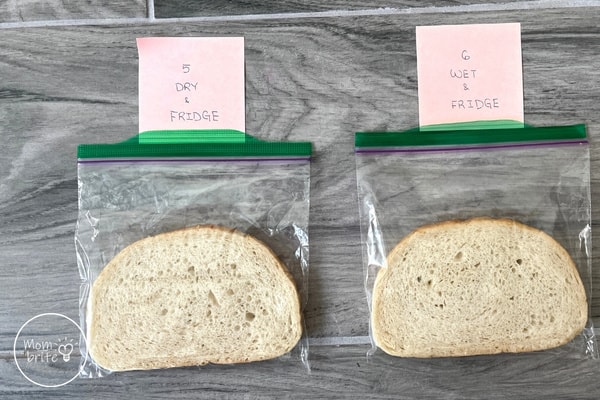
Both bread slices were mold-free (at least as far as we could see), even though one of them was wet. It would appear that placing the bread in the fridge and subjecting it to a cold temperature effectively prevented mold growth.
The question was whether the cold temperature or the light more effectively prevented mold growth on bread. So, let’s look at the bread slices that were both exposed to sunlight.
Comparison 4: “Dry & Sunny” vs. “Wet & Sunny”:
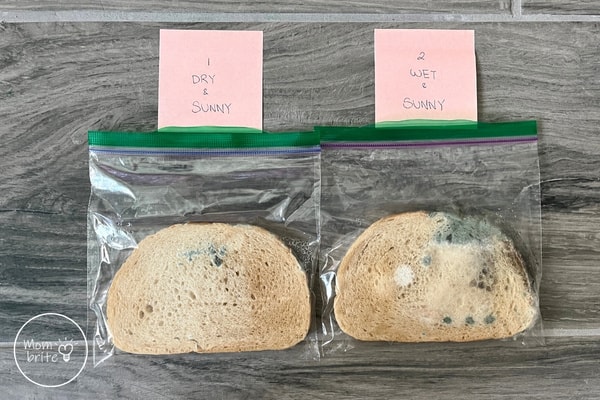
Even though we learned that the bread pieces exposed to sunlight had less mold than the ones placed in a dark environment, sunlight still did not completely prevent mold growth. We could still see a decent amount of mold on the wet slice of bread and minimal mold growth on the one we kept dry.
Comparison 5: “Dry & Dark” vs “Wet & Dark”
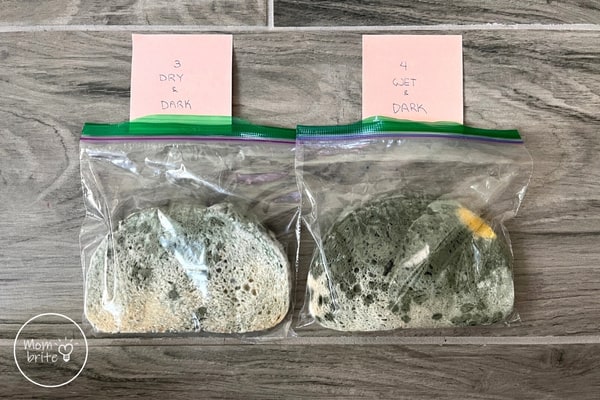
From the above comparisons, we already saw that light is a major factor in preventing mold growth on bread. When you compare the dry and wet slices placed in the kitchen cabinets, you can see that both had a lot of mold growth.
The wet bread slice had much more mold growth than the piece that was kept dry.
Moldy Bread Science Project Conclusion
From the comparisons, this experiment had much to observe and analyze. By combining all the observations, you could conclude how to prevent mold growth. That’s why the moldy bread experiment is a great science project for the science fair.
Finally, what did we conclude from the moldy bread experiment? We should store bread in the fridge when possible. If not, keep the loaf of bread dry and in a place that is exposed to light!
Moldy Bread Experiment Printable Worksheets
Unlock the mysteries of microbial growth with our Moldy Bread Experiment worksheets! Perfect for teachers and home educators, these worksheets guide students through a fascinating science project that explores how mold develops on bread.
Designed to be informative and engaging, they include step-by-step instructions, observation journals, and critical thinking questions. Each worksheet is thoughtfully designed to walk kids through the scientific method, from formulating hypotheses to recording observations and drawing conclusions.
Click on the image below to purchase the entire set of Moldy Bread Experiment worksheets!
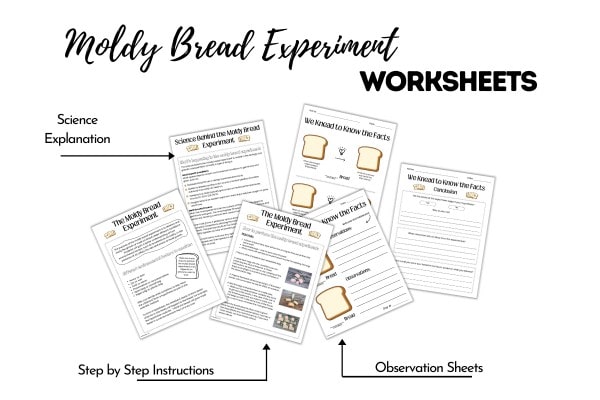
Be the “fun-gi” that kids adore and and bring science to life today with these Moldy Bread Experiment worksheets!
If you would just like the observation sheets, you can download them for free by clicking the image below.

YOU MAY LIKE:

i love leaving little boys in my basement and see if they grow any mold